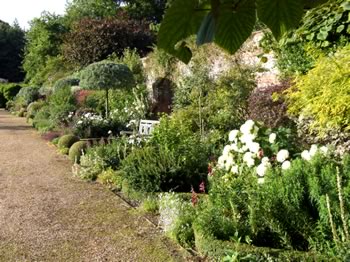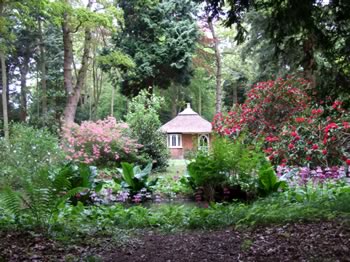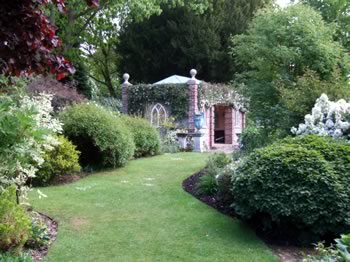The History of the Garden at Lexham Hall
The layout of the early gardens is unknown but some of the early to mid 18th century walls in the kitchen garden, which include a rare example of a 'crinkle-crankle' wall on the north side, may have enclosed a formal garden.
Some of the 19th century woodland and the American Garden (Suttons), immediately to the south of the River Nar still exist. These were almost certainly planted in the 1840s, a creation of Mrs Frances Keppell, wife of Rev. W A W Keppell. Kew Gardens are known to have supplied 32 hardy and half-hardy trees and shrubs to be planted in the gardens in 1855. Some traces of the 19th century formal gardens also still exist.
The splendid Gardeners Cottage, together with the greenhouses and service buildings were built between 1850 and 1870 and the summerhouses were also built during this period. A large conservatory, which stood to the southwest of the Hall, was demolished prior to 1911.

The Formal Garden
The gardens, like the park, have suffered significantly over the years from the damage caused by gales notably in 1895 and 1947. Restocking of the garden with American species started in 1989/90.
The formal gardens were totally destroyed during the Second World War and the gardens of today were designed and planted by Mrs William Foster with the help of Dame Sylvia Crowe and Jim Russell between 1948 and 1986. The gardens contain many hundreds of different species of plants, shrubs and trees. Notably fine examples of Judas Tree (Cercis silaquastrum), Foxglove Tree (Paulownia tomentosa) and many interesting climbers including Actinidia kolomitka, Vitis coignetiae and mature Wisterias together with 'old fashioned' shrub, climbing and species roses can be found in the Formal Garden.
The Woodland Garden contains numerous fine examples of Giant Redwood (Sequoiadendron) over 130 feet high, Dawn Redwood (Metasequoia glyptostroboides), Coastal Redwood (Sequoia sempervirens), Handkerchief Tree (Davidia involucrata), Katsura Tree (Cercidyphyllum japonica) and mature Magnolias including M. Campbellii, M. Wilsonii, M. Salicifolia, M. Cylindrica, M. Hypoleuca. There is also a fine collection of Rhododendrons, many dating back over 50 years, a Tulip Tree (Liriodendron fastigiata), a Bladdernut (Staphyllea pinnata) and a superb collection of Camellias.

The Summer House in the Woodland Garden
Today
Today the gardens are open five days a year for charity which includes several days for the National Gardens Scheme. www.ngs.org.uk
Groups can also visit by appointment between April and September. £300.00 for a guided tour of the garden for a maximum of 50 people to include tea, coffee and homemade biscuits or cakes. The tour of the garden lasts approx 1.5 hours and 45 minutes should be allowed for refreshments.
Articles on the garden have featured in Country Life, Gardens Illustrated and the Eastern Daily Press.

The Long Walk

The Tennis Pavilion